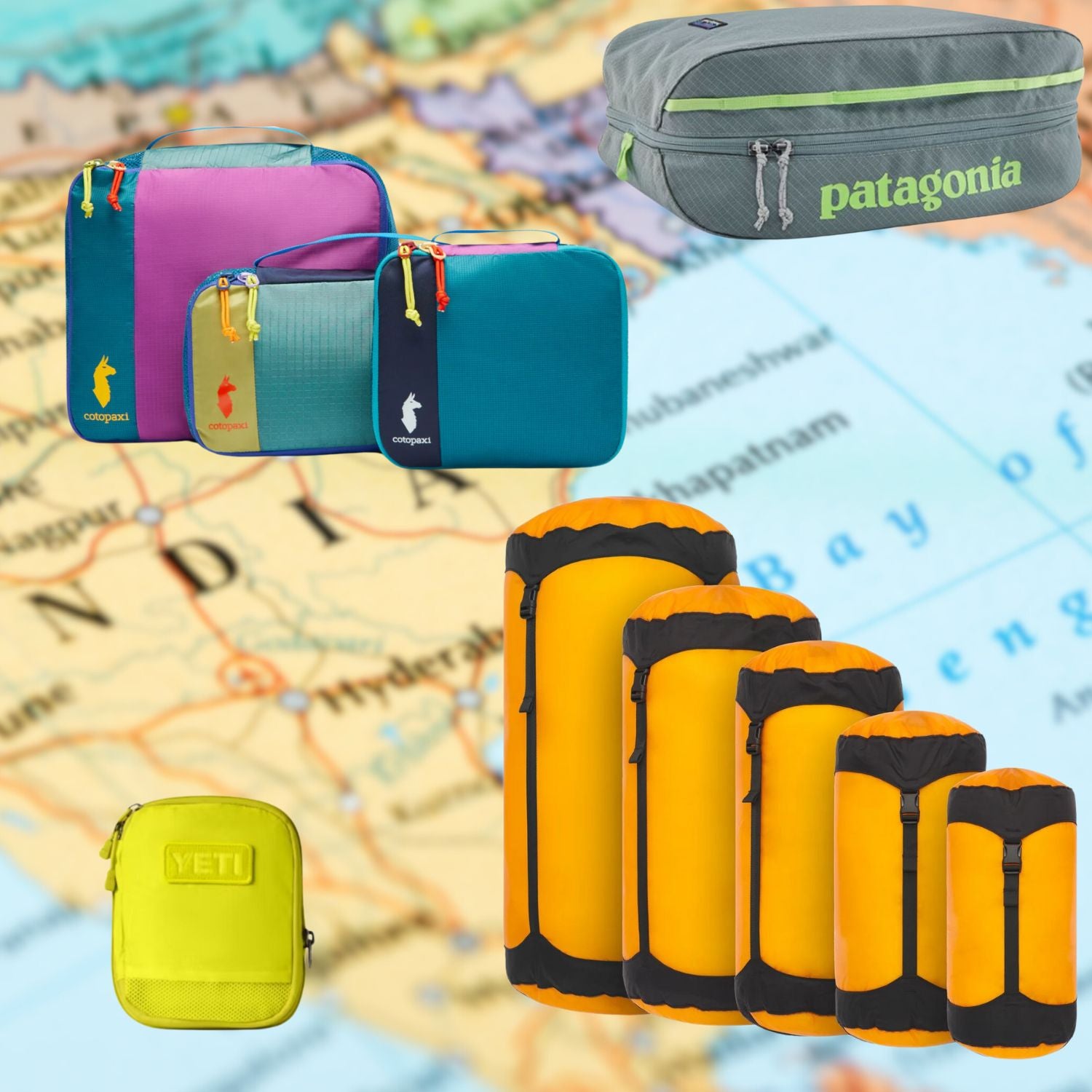As a seasoned traveler, I consider myself a good packer. I suspect you do, too. Most people do.
It’s human nature, I think, to presume our organizational skills are better than everyone else’s—a sort of Dunning-Kruger effect for human’s ability to cram a carry-on with a week’s worth of clothes. But unless you’re using packing and/or compression cubes, you’re doing it wrong. Trust me, that’s just the fact.
For years, I avoided compression cubes, mostly because I assumed they were more hassle than they were worth. I was also, to put it generously, an inveterate tightwad. Throwing down $50 dollars on a nylon bag to pack something inside it, which was then packed inside something else, felt ridiculous. Why waste the money, and the extra effort?
I was wrong. Once I started traveling every other week for work, I quickly realized I needed a better system than “always roll, never fold.” That wasn’t getting me there. And neither was jamming whatever didn’t fit in my suitcase into the bottom of my carry-on backpack like a chipmuck stockpiling nuts for winter. So I bought a couple of cheap packing cubes to help organize everything. I then made the full transition to packing-cube evangelist once it became clear how much easier compression cubes made everything.
Not only do they create more space, but they allow you to be more organized while on the go. No need to constantly unpack and repack every item each time you want a pair of socks from the bottom of your bag. They also allow you to cordon off certain items from others. For example, you can keep dirty and clean clothes in separate cubes or even stash hiking shoes next to your pants without worrying about mud stains.
Those benefits may seem basic, but over the course of a weeklong trip, one with multiple destinations, those little cubes can save valuable minutes and reduce re-packing headaches. Here’s a primer on how to deploy compression and packing cubes effectively, as well as our guide to the best ones on the market.
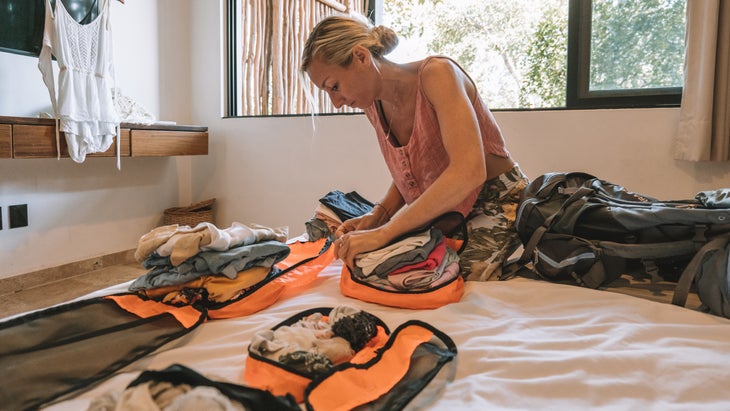
Basic Packing Cube Guidelines
➡️ Decide Between Compression vs. Packing Cubes
It may seem obvious, but too many people confuse general packing sacks with compression cubes. The latter actually compresses items inside them to make all your��items fit in a smaller space. They do this through zippers that get progressively tighter, straps that cinch down, or even vacuum sealing. Having both a couple compression cubes and packing sacks is ideal. Compression cubes are particularly helpful for clothes, especially loose items like socks and underwear, which can be condensed into a much tighter space. General packing bags are good for keeping organized and, if they’re large enough, offering a place to stash items like shoes.
➡️ Invest in at Least Three Different Sized Cubes
Like Goldilocks, having a few bags will allow you to find an option that’s just right for whatever you’re packing, whether it’s a down jacket or four pairs of boardshorts for a surf trip. I often bring four or five cubes: a large compression cube for large clothing items; a large packing bag for a pair of shoes; one for socks and underwear; one for the bottom of my backpack to hold a complete outfit, just in case (pants, a long-sleeve shirt, socks, and underwear); and a toiletries bag, which is basically its own form of a packing cube. When I’m traveling overseas, I also have a little pouch for cords to keep my power adapter and other electronic necessities in one spot. As the trip unfolds, I eventually transition my large compression cube into a bag for dirty clothes, to keep them separate from clean ones (which has the added benefit of making unpacking easier once I get home).
➡️ A Dedicated Shoe Bag Is Highly Underrated��������
I’m a fanatic about traveling with just carry-on luggage, which means I limit myself to two pairs of shoes: the ones I wear on the plane and another pair packed in my roller bag. But if the trip involves basically any activity, especially hiking—or even strolling through a foreign city—chances are I’m going to get my boots or sneakers wet or muddy. Until I bought a shoe bag, I’d have to pack those soggy sneakers next to my pants or shirts and risk getting them dirty, too. But with the bag, I can pack them in my roller bag wherever it fits best and not worry about cross-contamination.
➡️ Get a Well-Designed Toiletry Bag��
I like to keep my toiletries organized, too, and most dopp kits are simply fancied-up stash bags with a single pocket and a zipper. That means that everything, from a hairbrush to a deodorant to sunscreen, goes into the same large compartment. If anything leaks, it gets over everything. And even if it doesn’t leak, you’re basically forcing your toothbrush to intermingle with your toenail clipper. Get one that has multiple, dedicated compartments to keep things separate and organized. If you’re bringing sunscreen, make sure it has a screw top, or put it in a different container so it doesn’t leak.
➡️ Use a Small Bag for Cords
I almost always travel with my laptop, and because I travel frequently, I have everything ready to go in a small bag. It holds my charging cord, an extra cord for my phone, and two small wall chargers, just in case. By always keeping them in the same small ditty bag, it’s an easy grab and go scenario when I’m packing for a trip.
The Best Compression Cubes, Pouches, and Sacks
Best All-Around: Eagle Creek Pack-It Isolate Compression Cubes��
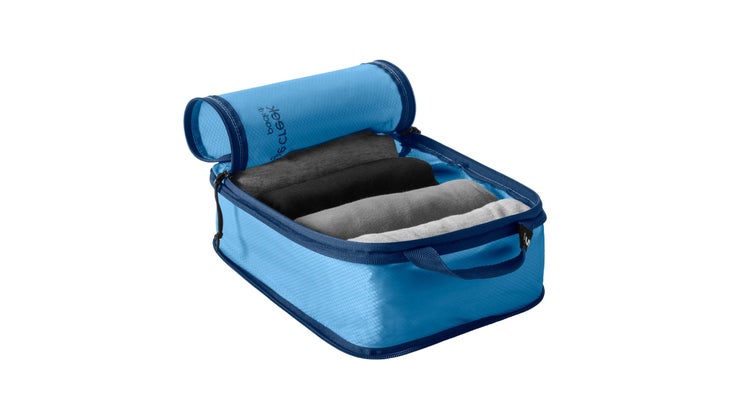
💰 Cost: From $25
Eagle Creek has long offered some of the best compression and packing cubes on the market, and these ones are the latest, greatest version. They come in multiple sizes and even as a set of two (starting at $50). The cubes help shrink clothes stashed inside via a zipper that, as you close it, pulls the bag and its contents together. These compressions pouches are made from 100-percent ocean-recycled fabric that’s water resistant, which means it’s great for packing bathing suits or wet towels while shuttling between stops on a multi-destination trip. As an all-around packing cube, these ones are hard to beat.
Also Great: Yeti Crossroads Packing Cubes

💰 Cost: From $25
Like all things from Yeti, these packing cubes are over-engineered—in a good way. They are, without doubt, the burliest compression cubes on the market and will stand up to years of abuse (with a three-year warranty). They come in three sizes, too: small, medium, and large. The small one is very small, basically good for cords and cables and other small items. But the large is great, big enough to keep pants and shirts organized. The zippers are particularly durable, which means you can overload these bags and get them to close (and compress as it does). If the cubes get dirty, say from muddy shoes or wet clothes, simply turn them inside out and toss them in the washer.
Best Large Cube: Patagonia Black Hole Cube
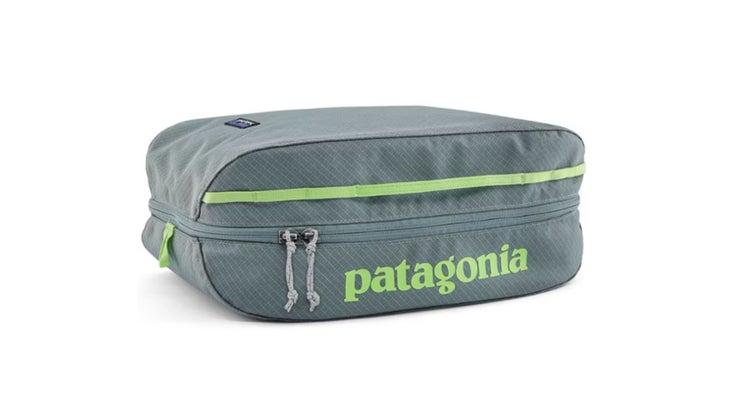
💰 Cost: $45
If you want one large packing cube to store most of your clothes on a trip, this is the one to get. At 14 liters, it’s the size of a daypack (i.e. it has plenty of storage), but it’s in the shape of a rectangle, so it fits snugly in a roller bag or duffel. It opens like a clamshell to reveal a zippered compartment on each side, both of which are big enough for multiple pairs of pants and long-sleeve shirts, or even a down jacket. One side is mesh, to see your items, and the other is covered with taffeta fabric to keep dirty items separate from the other compartment. The cube doesn’t compress items but, in a pinch, it will work as an extra, separate bag if you pick up too many souvenirs.
Best Multi-Cube Bundle On a Budget: Cotopoxi Cubo Packing Travel Bundle – Del Día
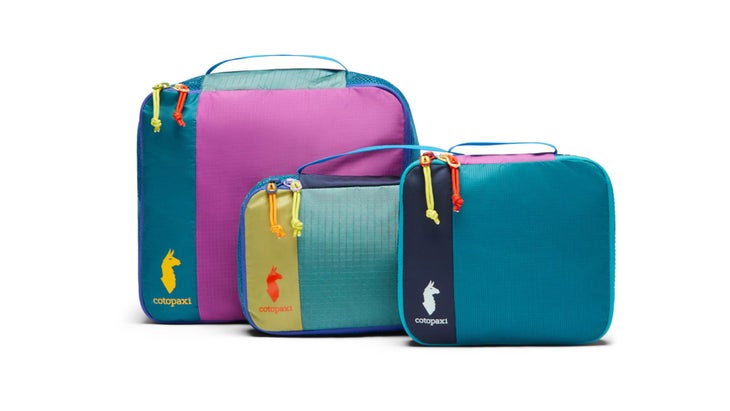
💰 Cost: $50
If you’re looking for a quick, simple purchase to complete your organizational quiver, this three-cube travel set is perfect. The cubes come in three sizes—two liters, three liters, and ten liters—and each has mesh sides for breathability and a way to see what’s inside. Each also has a wrap-around zipper that makes packing and compressing a cinch. In short, this is a great starter set if you have any doubts about the efficiency of packing cubes.
Best for Clothes Organization: Thule Clean/Dirty Packing Cube
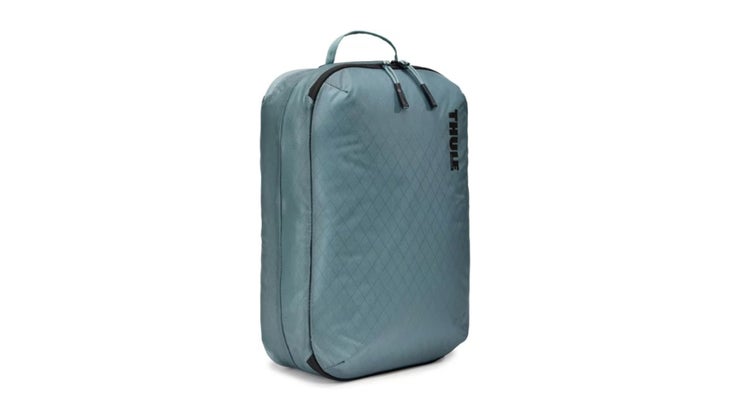
💰 Cost: $34
These days, plenty of companies offer packing cubes designed with “clean” and “dirty” compartments to keep your clothes organized and fresh while traveling. But this one from Thule is excellent, with a thermoplastic polyurethane divider between its two compartments that prevents dirt, moisture, and odor from transferring from one side to the other. At 13 liters, it’s huge, too, so you can pack a week’s worth of clothes inside. Made primarily from ripstop nylon, it’s both water repellant and durable, and because the exterior fabric is semi-transparent, you can even see the colors of the clothes inside to know which items are where. With a webbing handle, you can also use it as a separate bag, if needed.
Best for Shoes: Peak Design Shoe Pouch
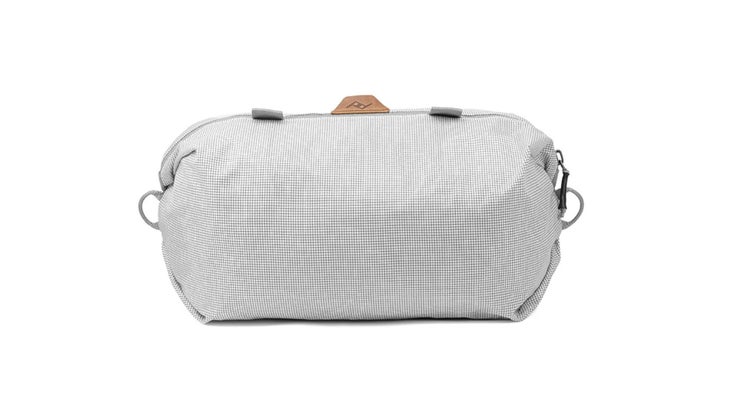
💰 Cost:$25
This durable nylon bag is perfect for holding a pair of shoes and sandals for a long weekend trip. It’s also big enough to fit mid- and high-cut hiking boots if you need to bring along some serious ankle support for trekking. The burly zipper will withstand years of abuse, and when you’re not using it, the bag packs down into its own storage pouch that’s just three inches long.
Best Compression Sack: Sea to Summit Ultra-Sil Compression Sack��
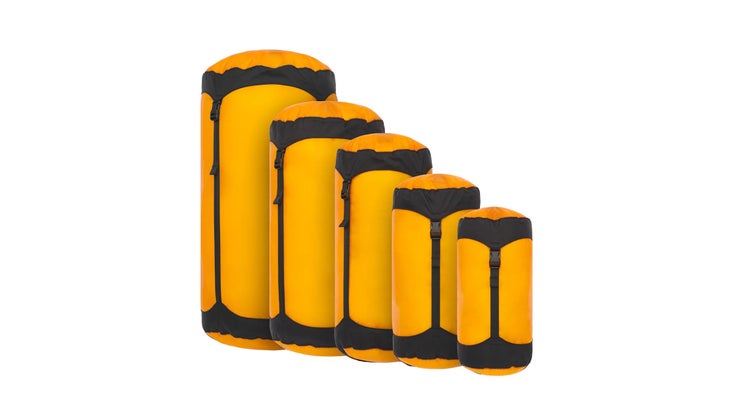
💰 Cost: From $35
Sometimes when traveling you need some serious compression capability—say if you’re traveling with a down parka or multiple fleece jackets or sweaters. This is when you need a compression sack like these from Sea to Summit. Essentially, they’re sleeping bag sacks, with buckle straps that you can crank down on to really shrink whatever is inside. These ones come in multiple sizes, from five to 35 liters. The diameter of each one is different, from 6 inches to 11.3, but they all fit inside a wheeled roller bag or most backpacks. It’s rare that you would need one when flying, but if you do need to compress something soft and bulky, this is the best way to do it.
Best Toiletries Gag: Gravel Toiletry Bag
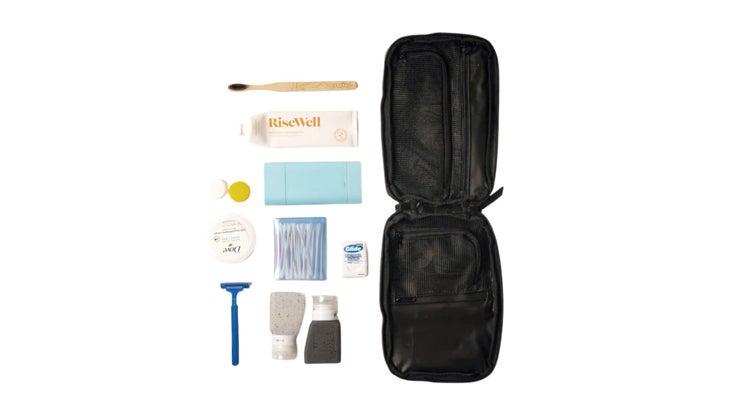
💰 Cost: From $40
This toiletry bag comes in four sizes, but the slim, at 9 x 5 x 2 inches and with six individual pockets, will work for most people. The multiple interior pockets keep everything organized. For example, a dedicated toothbrush compartment means your comb or toenail clipper won’t rub up against the tool you’ll be putting in your mouth.
Ryan Krogh is a freelance writer and editor based in Austin, Texas. In the last decade, he’s traveled to 27 countries and every U.S. state, nearly all with just a carry-on suitcase, thanks to packing light and using compression cubes. He has recently written a guide to carry-on luggage, the best vacation spots abroad in 2025, and airports with amazing outdoor spaces.



